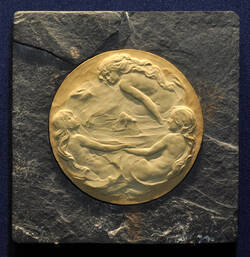An energetic and strong-willed Richard Wagner, and next two him the three Rhine-maidens in the water, dancing around the Rheingold. Here, the strict composition of Wagner's portrait, there sensuality, grace and merriment. When Paul Sturm cut the models for the Wagner medals in stone, he was at the height of his artistic powers.
The sculptor and medallist Paul Sturm is one of a number of German artists who significantly influenced the medal art of their day. Until the turn of the 20th century, very little was happening in the genre. Then Paul Sturm arrived, and the art historian Alfred Lichtwark with his call to "revive the medal", and they injected new energy into the medallist's art. Art nouveau did the rest, and suddenly the middle classes rediscovered their appreciation of medals and plaques.
Paul Sturm can claim credit for reintroducing the stone die-cutting technique that had been common during the Renaissance in Germany. One of his many models cut in Solnhofen stone is the Richard Wagner medal of 1903. The then director of the Dresden museum, Georg Treu, took such a liking to the stone carvings that he purchased them for the sculpture collection at the Albertinum.
Further Media
- Location & Dating
- pre 1904
- Material & Technique
- Solnhofen limestone in a granite frame
- Dimenions
- Dm: 8,0 cm
- Museum
- Skulpturensammlung
- Inventory number
- ZV 2159
